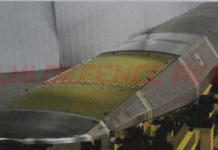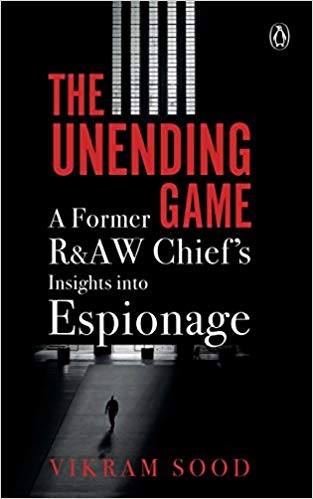“Nothing should be as favourably regarded as intelligence;
Nothing should be as generously rewarded as intelligence;
Nothing should be confidential as the work of intelligence,”
– Sun Tzu
A great book is one that prompts the reader to contemplate its content even after they finish reading it. Once such book is The Unending Game by Vikram Sood, Ex-Chief of India’s Research and Analysis Wing (R&AW), who headed the agency between 2001 and 2003, the tumultuous years that followed the Kargil intrusion, the Lahore declaration – debacle and the IC – 814 hijack. Despite being a slim book of 270 pages, it is an essential primer on many intelligence-related subjects, written as it has been by a practitioner of the ‘unending game’. Candour in a memoir is something that in most cases, assures sales. Candour when writing about world issues requires gumption, which, if given a choice, most ex-chiefs would shy away from.
In a country where the average citizen imagines an intelligence agent or spy in the mould of an onscreen avatar of Salman Khan – a shirtless, banian dhaari with biceps, riding a bicycle, kissing and colluding with a romantic interest from an enemy country to jointly stop a terror plot, while also singing and dancing, the real world of intelligence is somewhat misunderstood, to put it mildly. The Unending Game provides its readers with a far more realistic picture of what intelligence agents do. It deals with a whole gamut of issues of concern to various intelligence agencies, including , operations, training issues, moles, espionage among friends, the growth of the private intelligence industry, continuing Cold war rivalries, geopolitical hotspots, post-colonial fault lines, secret societies & cabals, active measures, SOCINT, HUMINT, IMINT, COMINT, OSINT, GEOINT challenges, financial terrorism , cyberwar, AI issues, ethics in intelligence, intelligence failures, challenges to the Asian Century, Deep State issues, Psy-Wars, Water Wars, Emerging power (India) issues and much more. Sood is straightforward in his assessments and the solutions he recommends to prepare India for the challenges of the 21st century.
Even though the intelligence profession is perhaps as old as any other, the author traces the origins of contemporary intelligence operations and strategies to the First World War (WW I), beginning with the British intercepts of the radio transmissions of their enemies which played an important role in winning that war. However, I do think the author could have added a page or two on the illustrious history of intelligence tradecraft in the Indian sub-continent, where spy agencies played a pivotal role in enabling imperial powers to subjugate the native population. As such, The Unending Game has essentially traced the history of intelligence from the last century to contemporary times.
The book has been structured in a manner wherein real world scenarios have been used to provide the context for various concepts that have been delved into. These examples are of course in the public domain., and the author, it seems, has taken extreme care to avoid anecdotes which might become controversial, so that the prime message of the book doesn’t get lost. As such, the author discusses threadbare various facets of running a serious intelligence agency, from operations, to the characteristics of an analyst, to the efficacy of training, to active measures, to regime changing recipes, to who watches the watchers, and finally to the requirements and efforts that go into the making of an ideal spy. The phrase “perfect spy” is actually mentioned a few times in the book.
Another noteworthy feature of Sood’s effort is the focus on the role played by ‘Secret Societies‘in the world of today. Of course, ever since Carroll Quigley, who had been given complete access to the Vatican archives wrote the tome, Tragedy and Hope which shed considerable light on the workings of Secret Societies, people have written innumerable books about such groups. But very few books written by former Intelligence Chiefs from India deal with the subject at length. Sood’s treatment of the subject allows the reader to look beyond the realm of conspiracy theory and get an understanding of the relevance that these groups truly have to world polity. Indeed, the author has striven to make the reader understand the dynamics of power at the global stage with ‘all kinds’ of prominent actors being examined. Including of course the veritable ‘Deep State’ which the author quotes Mike Lofgren to define :
“It’s a mysterious entity as a social network committed to its own enrichment & perpetuation . It is in a class by itself in terms of global reach and financial resources but is neither omniscient nor invincible .It has some sinister aspects to its functioning , aims and effects but the important aspect is that it is well entrenched ”.
In any case, some prominent power clubs which were created for the sole purpose of preserving the interests of the elites mentioned in the book are the ‘Pinay Cercle’, the ‘First Name Club’, ‘Gladio A&B’, ‘The Safari Club’, ‘The Bilderbergers’, ‘The Council for Foreign Relations’, and the ‘Trilateral Commission’.
This begs the question: What then is India’s place in the world? The author feels that without enunciating a grand narrative which encompasses both short term and long term objectives and identifies the means to achieve them, India will continue to punch below its weight. In this passage where Sood explains how Jihad was essentially “made in America”, he also reveals how the world is shaped by those who wish to make it in their own image:
“1980s saw the most massive and best known covert operation of the cold war when the US & its allies used the Jihadi option to defeat the Soviet Union in Afghanistan with the President Reagan describing the Jihadis as moral equivalent to the founding fathers of America. Selected Jihadis were trained in American facilities like Fort Bragg, Northern Carolina and at the CIA’s Camp Perry and other locations in Virginia. About 80,000 others were trained for jihad by ISI in 4 years. Forty threes Islamic countries participated in the Jihad. Apart from the money generated by the Americans and Saudis, opium cultivation in Afghanistan and the processing of opium into heroin in Pakistan was encouraged to start the war. “ISI is currently about 25000 strong which has morphed into a special operations force that recruited , trained and equipped and sent out Jihadis during the Afghan jihad under CIA’s tutelage, assistance & training.”
“Post 911 intelligence in the US has been massively upgraded and privatized on a scale unimaginable in the recent times. The total intelligence budget of the US intelligence agencies as per disclosed is about 70 billion dollars roughly equal to or more than the India’s annual Defence budget “.
“Today after a decade and a half of the so-called war on terror fought all over the Muslim World , victory seems no nearer than it was in October 2001. The top secret world the government created in response to the terrorist attacks of 11 Sept 2001 has become so large , so unwieldy and so secretive that no-one knows how much money it costs, how many people it employs ,how many programs exist within it or exactly how many agencies do the same work .- Therein lies the truth and the future .”
“US still believes in its manifest destiny to rule the world, while the Chinese presume they are the Middle Kingdom & both the nations feel the world owes them eternal gratitude for existing whilst overstating their narcissist beliefs and refusing to accept that the world has begun to change “
He does portray a grim picture for the future if suitable steps aren’t taken. Wars will be fought over water by governments (and multinationals, too) with water being turned into a truly marketed commodity. Artificial intelligence usage is a huge grey area which, if unregulated, could lead to catastrophic effects. Competition over resources will lead to wars which might be cold or hot depending on the flashpoints. Already a competition is underway between the oil producing nations led by the US and gas producing nations led by Russia. China, with its flagship One Belt One Road, of which the ‘China Pakistan Economic Corridor’ is a key part, will strive to preserve its economic interests and military presence along the new trade routes of the world.
In the midst of all this, Sood also laments the rather serious inability and unwillingness on the part of the Indian ruling elite to understand the ethos of Pakistan, its army, its elites, its thought process and its source of ideological sustenance. Peace with India is not part of this ideology, he claims. Having said that, other reviews of this book seem to have quite obsessively focused on issues related to Pakistan, while missing the larger ethos of the work, which is the detailing of global power structures and the tools required for a country to harness power on this planet.
Indeed, one would say that Sood has set the bar extremely high for books that deal with intelligence and such. It will, no doubt, serve as a template for future chiefs, if they wish to write, and there is a crying need for such literature to be produced in India. These prophetic words of the author are perhaps an apt way to conclude:
“Statecraft is a mixture of diplomacy, military power, economic strength and intelligence capabilities. No single factor by itself will be enough to attain our goal to be a great power. Greatness is not going to be thrust upon us or granted in charity .We have to achieve it on our own – by force , stealth or deception .”
Vedesh M Gangur is a keen observer of geopolitics. He tweets at @VedeshMG
© Delhi Defence Review. Reproducing this content in full without permission is prohibited.
































